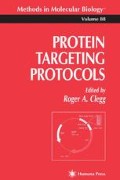Abstract
The ability to express recombinant proteins in eukaryotic systems by transiently expressing cloned cDNAs in cell lines, such as COS-1, COS-7 (1), or human embryonic kidney HEK293 cells (2), has enabled rapid analysis of a variety of wild-type and mutant signal transduction polypeptides. These have included receptors, G proteins (α-, β-, andγ-subunits), and effector molecules. This chapter aims to outline the techniques used in such experiments and to highlight potential problems, which, unless specifically investigated, may not normally be appreciated.
Access this chapter
Tax calculation will be finalised at checkout
Purchases are for personal use only
References
Cullen, B. R. (1987) Use of eukaryotic expression technology in the functional analysis of cloned genes. Methods Enzymol. 152, 684–704.
Didsbury, J. R., Uhing, R. J., Tomhave, E., Gerard, C., Gerard, N., and Synderman, R. (1991) Receptor class desensitization of leukocyte chemoattractant receptors. Proc. Natl. Acad. Sci. USA 88, 11,564–11,568.
Galbiati, F., Guzzi, F., Magee, A. I., Milligan, G., and Parenti, M. (1994) N-terminal fatty acylation of the G-protein Gi1: only the myristoylated protein is a substrate for palmitoylation. Biochem. J. 303, 697–700.
Parenti, M., Vigano, M. A., Newman, C. M. H., Milligan, G., and Magee, A. I. (1993) A novel N-terminal motif for palmitoylation of G protein α subunits. Biochem. J. 291, 349–353.
Grassie, M. A., McCallum, J. F., Guzzi, F., Magee, A. I., Milligan, G., and Parenti, M. (1994) The palmitoylation status of the G-protein Go1α regulates its avidity of interaction with the plasma membrane. Biochem. J. 302, 913–920.
Hallak, H., Brass, L. F., and Manning, D. R. (1994) Failure to myristoylate the α subunit of Gz is correlated with an inhibition of palmitoylation and membrane attachment, but has no affect on phosphorylation by protein kinase C. J. Biol. Chem. 269, 4571-4576.
Wilson, P. T. and Bourne, H. R. (1995) Fatty acylation of αz. J. Biol. Chem. 270, 9667–9675.
Wedegaertner, P. B., Chu, D. H., Wilson, P. T., Levis, M. J., and Bourne, H. R. (1993) Palmitoylation is required for signaling functions and membrane attachment of Gqα and Gsα. J. Biol. Chem. 268, 25,001–25,008.
McCallum, J. F., Wise, A., Grassie, M. A., Magee, A. I., Guzzi, F., Parenti, M., and Milligan, G. (1995) The role of palmitoylation of the guanine nucleotide binding protein G11α in defining interaction with the plasma membrane. Biochem. J. 310, 1021–1027.
Miller, J. and Germain, R. N. (1986) Efficient cell surface expression of class II MHC molecules in the absence of associated invariant chain. J. Exp. Med. 164, 1478–1489.
Andersson, S., Davis, D. N., Dahlback, H., Jornvall, H., and Russel, D. W. (1989) Cloning, structure and expression of the mitochondrial cytochrome P-450 sterol 26-hydroxylase, a bile acid biosynthetic enzyme. J. Biol. Chem. 264, 8222–8229.
Author information
Authors and Affiliations
Editor information
Editors and Affiliations
Rights and permissions
Copyright information
© 1998 Humana Press Inc.
About this protocol
Cite this protocol
Grassie, M.A., Milligan, G. (1998). Molecular Genetic Approaches IV. In: Clegg, R.A. (eds) Protein Targeting Protocols. Methods in Molecular Biology™, vol 88. Humana Press. https://doi.org/10.1385/0-89603-487-9:151
Download citation
DOI: https://doi.org/10.1385/0-89603-487-9:151
Publisher Name: Humana Press
Print ISBN: 978-0-89603-487-7
Online ISBN: 978-1-59259-572-3
eBook Packages: Springer Protocols

